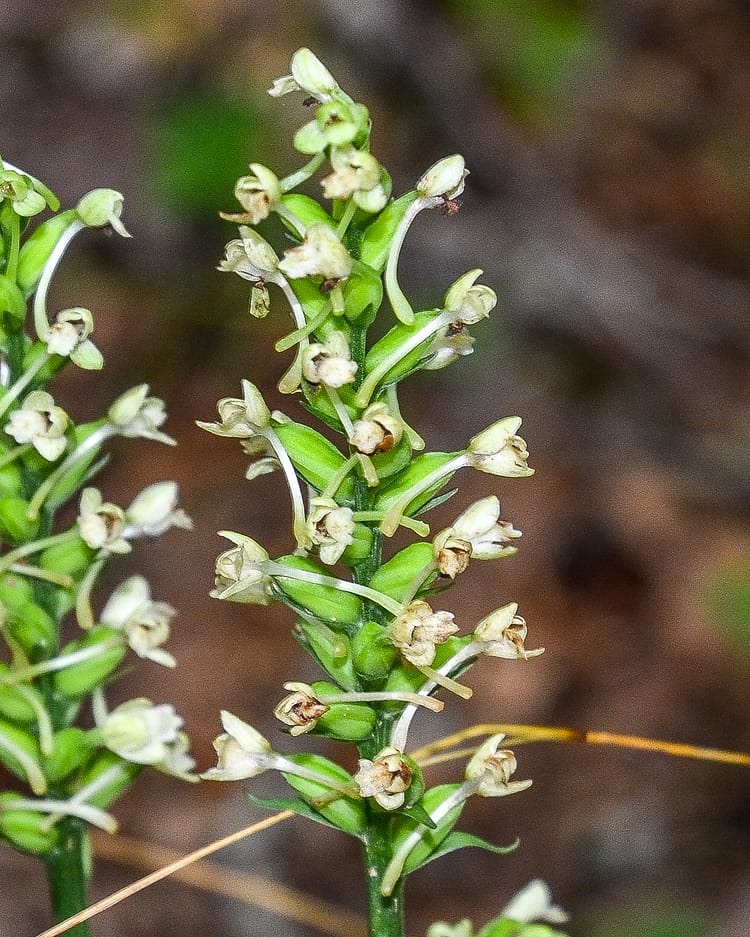In early August, we revisited the trail to Buzzard Rock in Rocky Fork State Park, just outside of Flag Pond, TN. A few years ago, we celebrated New Year’s Eve here, logging 14 miles and fording streams laced with icicles on our journey. We followed up this hike with two trips to GSMNP, counting the orchids along the way.
Rocky Fork is a gorgeous 2,100 acre tract on the western slope of the Southern Appalachians, located below the Appalachian Trail that snakes along the North Carolina/Tennessee border. Rocky Fork is adjacent to the Cherokee National Forest in Tennessee and the Pisgah National Forest in North Carolina. It also shares a boundary with the Sampson Mountain Wilderness in TN, within the Cherokee National Forest and comprising 10,000 acres.



Great Smoky Mountains National Park
The day after our Rocky Fork hike, we returned to GSMNP to see what else was in bloom. We moved to the Asheville in 1990, and haven’t done much in GSMNP, mostly because we have dogs who like to hike.
Due to health issues and summer heat, we didn’t bring our dogs. This is a liberating win/win; we take them on smaller jaunts, and are able to expand our local hiking range.

We hiked 12 miles on this trail, surrounded by picturesque, rocky streamside scenery and cooled by crystal clear waters teeming with trout.

It is the season for one of our most prolific orchids, Goodyera repens, or Downy Rattlesnake Plantain. Butterflies were also in abundance, from pipevine swallowtails to monarchs.

This skipper was busy feeding on Prunella vulgaris or Heal-all.

Great Smoky Mountains: Three Birds Orchid
The most thrilling find in GSMNP was Three Birds Orchid, Triphora trianthophora, which has eluded me for years! Well, it is still on my list for the future, as it was incredibly difficult not only find, but also capture images of this stunning orchid.
Another common name for Three Birds Orchid is Nodding Pogonia. A few months ago, I found Rosebud Orchid, also known as Rose Pogonia. You can read about that here: https://hikescape.org/fire-rain-and-rosebud-orchids-on-the-at/

What I love about this orchid is the variation in its appearance during bloom. WOW! Each bloom (which can be up to three flowers per stem) is initially pendulous, perched atop the slender burgundy stems, eventually becoming upright. The flower reveals a lightly speckled, frilled lip tp entice pollinators.
This orchid is TINY, and it needs specific conditions to produce these exquisite blooms. Three Birds Orchid is the subject of conservation and research; the Forest Service provides a great description of this beauty: https://www.fs.fed.us/wildflowers/plant-of-the-week/triphora_trianthophora.shtml

The Forest Service describes a synchronous bloom cycle for Three Birds Orchid. Over a two week period, the orchids that I found were in varied phases of bloom, and all were within a mile of each other, at slightly different elevations. During that period of time, these locations fluctuated in temperature, rainfall, and directional exposure.

My own personal “urban” dictionary includes the term “FLORGASM” to describe the experience of finding new wildflowers. I can say with certainty that I was sated by the end of this hike!

For those of you who are plant nerds, you may find this paper about Three Birds Orchid interesting: http://www.nativeplanttrust.org/documents/130/Triphoratrianthophora.pdf
Cranefly
The Cranefly orchid continues its understudy role this season, glistening in the filtered sunlight, but not stealing the show.

It was hard to miss this spike of Cranefly orchid!

Other vascular plants in GSMNP
Here is a wildflower that I hadn’t seen before, which I guessed was in the Aster family. The flowers are exquisite and in stark contrast against the green backdrop!

The intense blue of the Asiatic Day lily caught my eye, as well as this insect’s attention.


I hope you will join us as we approach the elk rut season in Cataloochee area of GSMNP. I continue to lag behind in recording hikes, including the beauty of Grassy Ridge near the Roan Mountains. We all know how quickly time slips by; in the interim, I am grateful to be immersed in nature whenever possible!


